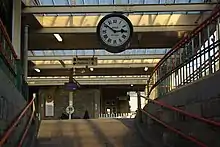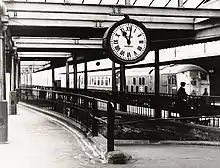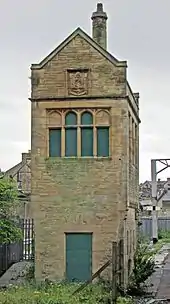Carnforth railway station
Carnforth railway station serves the town of Carnforth in Lancashire, England. The building was designed by architect William Tite and was used as a location in the 1945 film Brief Encounter. It is now operated by Northern and situated 6 miles (9.7 km) north of Lancaster on the West Coast Main Line.
 | |
| Location | Carnforth, Lancaster England |
| Coordinates | 54.130°N 2.771°W |
| Grid reference | SD496706 |
| Managed by | Northern |
| Platforms | 2 |
| Other information | |
| Station code | CNF |
| Classification | DfT category F1 |
| History | |
| Original company | Lancaster and Carlisle Railway and Ulverstone and Lancaster Railway |
| Pre-grouping | LNWR, Furness Railway and Midland Railway joint |
| Post-grouping | London Midland and Scottish Railway |
| Key dates | |
| 22 September 1846 | L&CR station opened as Carnforth-Yealand[1] |
| February 1864 | L&CR station renamed Carnforth[1] |
| 6 June 1857 | U&LR station opened as Carnforth[1] |
| 2 August 1880 | The two stations were replaced by a single station[1] |
| May 1970 | West Coast Main Line platforms closed |
| Passengers | |
| 2015/16 | |
| 2016/17 | |
| 2017/18 | |
| 2018/19 | |
| 2019/20 | |
| Notes | |
Passenger statistics from the Office of Rail and Road | |
Route 7: Bentham Line and Settle & Carlisle Line | |||||||||||||||||||||||||||||||||||||||||||||||||||||||||||||||||||||||||||||||||||||||||||||||||||||||||||||||||||||||||||||||||||||||||||||||||||||||||||||||||||||||||||||||||||||||||||||||||||||||||||||||||||||||||
|---|---|---|---|---|---|---|---|---|---|---|---|---|---|---|---|---|---|---|---|---|---|---|---|---|---|---|---|---|---|---|---|---|---|---|---|---|---|---|---|---|---|---|---|---|---|---|---|---|---|---|---|---|---|---|---|---|---|---|---|---|---|---|---|---|---|---|---|---|---|---|---|---|---|---|---|---|---|---|---|---|---|---|---|---|---|---|---|---|---|---|---|---|---|---|---|---|---|---|---|---|---|---|---|---|---|---|---|---|---|---|---|---|---|---|---|---|---|---|---|---|---|---|---|---|---|---|---|---|---|---|---|---|---|---|---|---|---|---|---|---|---|---|---|---|---|---|---|---|---|---|---|---|---|---|---|---|---|---|---|---|---|---|---|---|---|---|---|---|---|---|---|---|---|---|---|---|---|---|---|---|---|---|---|---|---|---|---|---|---|---|---|---|---|---|---|---|---|---|---|---|---|---|---|---|---|---|---|---|---|---|---|---|---|---|---|---|---|
| |||||||||||||||||||||||||||||||||||||||||||||||||||||||||||||||||||||||||||||||||||||||||||||||||||||||||||||||||||||||||||||||||||||||||||||||||||||||||||||||||||||||||||||||||||||||||||||||||||||||||||||||||||||||||



Carnforth station, shortly before main line electrification.

History
Carnforth railway station was opened in 1846 by the Lancaster and Carlisle Railway (L&CR). It had a single platform and was a second-class station. It became a junction in 1857 when the Ulverston and Lancaster Railway arrived from the northwest, the station was its southern terminus. The Furness Railway took over the U&LR in 1862 and became the second major company operating to Carnforth.
The station was enlarged during the 1870s and in 1880 received trains from the Midland Railway following the commissioning of a south-to-east direct curve to the Furness and Midland Joint Railway that created a triangular junction. The L&CR was taken over by the London and North Western Railway (LNWR). Carnforth Station was operated under a joint management by the Furness and LNWR compnies - the Midland having Running Powers into the station. Station personnel wore a uniform with the initials CJS for Carnforth: Joint Station. The Furness Railway erected a distinctive stone-built signal box to the north-west of the station in 1882, used until 1903, and this survives preserved as a listed building.
A major rebuilding project, including a 300-yard long platform (currently used by northbound services), started in 1938 with government funding. With the opening of the new Platform on 3rd July 1939, it brought the number of platforms in use to six. In 1942, the government approved the rebuilding of Carnforth MPD into a major regional railway depot - the work being completed in 1944.
The film Brief Encounter was partly filmed at the station in February 1945. The station clock became a powerful icon through repeated use in the film.
Withdrawal of main line services
The West Coast Main Line (WCML) platforms were closed in May 1970, following the withdrawal of local stopping passenger services between Lancaster and Carlisle two years earlier. The platform walls facing the fast lines were demolished, cut back and fenced off before the commissioning of 25 kV overhead electrification in 1974. This made Carnforth a secondary line station, even though it is situated on the main line, as WCML trains cannot call.
In 2011, Network Rail rejected proposals to reopen the mainline platforms, stating that there would be too few passengers to justify slowing down mainline trains.[2] Only the former platforms 4 (the original Furness Railway through platform) and 6 (the LMS 1939 platform)(now renumbered 1 & 2) remain in use; as the old 'Midland bay' (No 5), which once catered for services on the Furness and Midland Joint Railway (between Carnforth and Skipton) has had its track removed.
Responsibility for the signalling at the station is divided between Preston PSB (main line) and the surviving manual ex-Furness Railway signal box at Carnforth Station Junction, sited just past the junction between the Barrow & Leeds lines. This has acted as the 'fringe' box to the PSB since the main line was resignalled in 1972/3. Two other boxes (F&M Junction & East Junction) were closed and demolished when the northern side of the triangle (avoiding the station) was decommissioned in 1998.
Refurbishment
After lying in a semi-derelict state for many years, the station buildings were refurbished between 2000 and 2003 and returned to commercial use. An award-winning Heritage Centre including a small railway museum and the "Brief Encounter" Refreshment Room, a number of shops and a travel/ticket office occupy the buildings.
The outer half of the non-operational up main (southbound) platform is in use as the access route to the subway, the active platforms and tea room. Since the privatisation of British Rail, the station has been operated by First North Western (1997-2004), First TransPennine Express (2004-2016) and Northern (2016 to date).
Facilities
The booking office is staffed part-time (six days per week, closed Sundays & public holidays) - it is run by an independent retailer on behalf of the local authority but sells a full range of National Rail tickets.[3] Both platforms have waiting rooms and step-free access (by the aforementioned subway ramps) from the station entrance, whilst train running information is provided by automated P.A announcements, timetable posters and digital information screens.
There is also a micropub called The Snug which was the first of its kind to be set up in the North West and has been in the CAMRA Good Beer Guide[4] They host an annual beer festival inside the Heritage Centre in mid to late November.
| Wikimedia Commons has media related to Carnforth railway station. |
Operators
Carnforth is served by Northern, who operate the following routes:
- regional express services from Manchester Airport to Barrow-in-Furness via the Furness Line (eight each way)[5] using Class 156s, Class 158s and since July 2019 the new Class 195 Civity units.[6]
- local services along the Furness Line to Barrow-in-Furness (hourly) and the Leeds to Morecambe Line to Skipton and Leeds (eight trains per day each way Mon-Sat, five on Sundays).[7] Some services continue beyond Barrow to Millom or Carlisle via the Cumbrian Coast Line. Northern services are operated using Class 153 and 156 diesel multiple-unit trains and occasional Class 142 on the Furness line while the Leeds line is operated by 150 units and Class 158 sets (the latter now appear on most services since the winter 2019 timetable was implemented and withdrawal of Pacer units began). A single early-morning direct service to Morecambe (using the north curve at Hest Bank) operates from here on weekdays as a Parliamentary train to provide a statutory minimum service over this stretch of railway.
When the current Northern franchise began in April 2016, all Furness Line services were transferred to a single operator, Northern, including those previously operated by First TransPennine Express. Management of the stations on the route, including Carnforth, has also been transferred as part of the franchise changeover. The timetable will be improved from 18-20 trains per day to 21 each way and more through trains to and from Manchester Airport (from four to eight, marketed under the 'Northern Connect' brand).[8]
To the west of the station lies Carnforth MPD, which is also the headquarters of West Coast Railways.
See also
References
- Butt, R. V. J. (1995). The Directory of Railway Stations: details every public and private passenger station, halt, platform and stopping place, past and present (1st ed.). Sparkford: Patrick Stephens Ltd. p. 54. ISBN 978-1-85260-508-7. OCLC 60251199.
- Johnston, Howard (10 August 2011). "Regional News". Rail. Peterborough. p. 24.
- Carnforth Station Details National Rail Enquiries station page; Retrieved 25 November 2016
- "The Snug Micropub".
- GB National Rail Timetable, December 2019; Table 82
- "New CAF Trains for Northern to Enter Service on 1 July 2019Railway News news article; Retrieved 13 November 2019
- GB National Rail Timetable, December 2019; Table 42
- Northern Franchise Improvements - DfT Archived 24 July 2019 at the Wayback Machine. Retrieved 14 December 2015.
External links
- Train times and station information for Carnforth railway station from National Rail
- Carnforth Station Heritage Centre
| Preceding station | Following station | |||
|---|---|---|---|---|
| Bare Lane | Northern Trains Lancaster - Morecambe (Limited service) |
Lancaster | ||
| Silverdale | Northern Trains Furness Line |
Lancaster | ||
| Arnside | Northern Trains Barrow-in-Furness - Manchester Airport |
Lancaster | ||
| Silverdale (limited service) |
||||
| Wennington | Northern Trains Leeds to Morecambe Line |
Lancaster | ||
| Historical railways | ||||
| Burton and Holme | Lancaster and Carlisle Railway | Bolton-le-Sands | ||
| Silverdale Line and station open |
Furness Railway Ulverston and Lancaster Railway |
Bolton-le-Sands Line open, station closed | ||
| Borwick | Furness and Midland Joint Railway | Bolton-le-Sands | ||